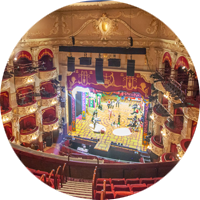
<< Go Back up to King’s Theatre

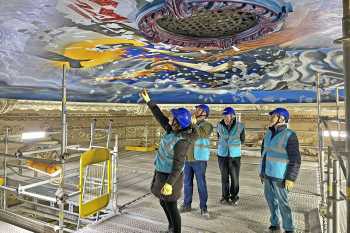
Since mid-2022, the King’s Theatre in Edinburgh, under the management of Capital Theatres  , has been undergoing a £35+ million redevelopment project. You can read more about it here
, has been undergoing a £35+ million redevelopment project. You can read more about it here  . Mike has been an ardent supporter of, and financial donor to, the King’s Theatre renovation project.
. Mike has been an ardent supporter of, and financial donor to, the King’s Theatre renovation project.
A “dancefloor” scaffolding platform (an elevated work platform) was installed in the center of the auditorium to afford direct access to the auditorium ceiling, whose main feature is a mural designed and painted by Scottish artist John Byrne in 2013. You can read more about the dome painting here  . The platform also affords access to other normally out-of-reach areas of the auditorium. Such platforms are a very standard piece of theatre interior renovation projects.
. The platform also affords access to other normally out-of-reach areas of the auditorium. Such platforms are a very standard piece of theatre interior renovation projects.
As a significant donor to the theatre’s redevelopment, in December 2024 I visited the King’s to checkin in progress. Read on for my remarkable discovery at the very centre of the theatre that I grew up in!
At the top of the plaster panels above the boxes flanking the proscenium arch, and at the top of the panel surmounting the proscenium arch itself, there are large plaster cartouches highlighted in gold and centered in each of the three panels. Above each of these is a plaster crown, a direct reference to the building being the King’s Theatre.
Although the plaster crowns don’t look particularly large from the audience’s perspective, they are actually more than 2ft (60cm) wide. As with all interior decoration that will never be viewed up-close, the plaster crowns are somewhat crude when viewed close up.
I had been up to the “dancefloor” before, however the day prior to my visit I’d been toured around the New Victory Theater in New York courtesy of Tim Dolan at Broadway Up Close  .
.
At the New Victory Theater there are plaster cherubs surrounding the rim of the auditorium ceiling dome, and when the theatre was renovated it was allegedly discovered that some of the cherubs’ heads had devils’ faces on the backs of their heads. The cherubs’ faces looking down into the auditorium with the devils’ faces in the opposite direction signified Good triumphing over Evil and casting that goodness over the theatre.
Perhaps because of the story from the New Victory Theater I was thinking about plasterwork in general when I visited the King’s, the hidden nature of what might be just out-of-sight, and the thought that plaster is only a surface sculpting material that is never solid. It occurred to me that the plaster crowns at the King’s Theatre would not be solid. Could there be anything behind, or even inside them?
To get a closer at the one plaster crown that was accessible – the central crown, directly above the center of the stage, I started with a camera phone in selfie mode, maneuvering it behind the plaster crown. There was not a lot of space (roughly 6in / 15cm) between the wall and the rear of the crown but it was clear that the plaster crown was hollow. The plaster exterior of the crown was arranged upon on a rough cross arrangement (presumably underlying wood) and there were four holes in the rear of the plaster crown.
The holes on the house right side of the crown were small. On the house left side the lower hole was the largest, and so just like in the scene from Indiana Jones and the Temple of Doom (1984)  I stuck my hand into the hole, not able to see anything of where I was putting it, to feel around inside the plaster crown.
I stuck my hand into the hole, not able to see anything of where I was putting it, to feel around inside the plaster crown.
The first thing I felt was loose crumbled plaster. Then as I dug deeper, I could feel cloth-like material, presumably something like hessian which would’ve been mixed with the plaster to give it better structure and rigidity. As I dug more, I could feel dampness. That was strange, because why would anything inside the plaster crown be damp when there was no liquid source inside? Why would anything in the building be damp, unless something was leaking?
Then, my hand hit something hard. And smooth. This was NOT crumbly plaster. Whatever it was, it was at the very extent of my reach from the scaffolding. Like the material I could feel, the hard thing had some dampness on it. What was it? I could feel it was loose, and so I pulled it back out through the hole, pleased that nothing had bit my hand like in the Indiana Jones movie.
Sharing the find with Capital Theatres’ staff John Robb and Lucille Bluefield, a joking question was asked: had anyone seen me actually get the bottle out of the crown or was it a plant?! Given my Indiana Jones experience and the fear of having my hand bitten off, I assured everyone that the find was genuine.
The bottle was covered in dirt, slightly damp, but rubbing off some of the dirt on the surface let us see the initials “TR” painted in large letters on the side of the bottle. The colour of paint this was done with looked like the shadow colour used in the auditorium.
Inside the bottle we could see paper, rolled-up and with lettering visible but reversed and unreadable. John thought the bottle looked like something from the 1950s or 1960s, and I surmised that there was a major renovation of the theatre in the early 1950s and so that timeframe was possible, however if it wasn’t the 1950s then the theatre hadn’t undergone a renovation prior and the bottle must date to the theatre’s opening.
Much, much later, and after a full progress tour of the exciting developments taking place throughout the theatre as part of the redevelopment project, we got the bottle back to a well-lit room and took a closer look at it.
Through the initials “TR” we could see a scroll of paper inside the bottle, and writing on it – but reversed. It seemed that the ink on the paper rolled-up inside the bottle had seeped through the paper to the rear and we were seeing this writing in reverse.
None of us could decipher the few letters we could see, however I had a lightbulb moment and remembered that iPhones have a “flip image” option, so we took photos of the indecipherable writing and flipped them, only to be immediately presented with the undeniable digits “1906” – the very year the theatre opened!
Further analysis by Capital Theatres determined that the writing ending with “& Son” was in fact “Cruikshank & Son”, the name of the contractor who built the theatre and whose company would ultimately own and manage the theatre. Several people I have shown the photos to think the writing prefixing the 1906 date says “October”.
Not long after the find, in mid-December 2024, the bottle was shared with the Scottish Conservation Studio  . The plaster seal and bottle-top was removed however it was not possible to remove the rolled-up scroll of paper without potentially damaging it. The next step will be to remove the base of the bottle to retrieve the paper intact.
. The plaster seal and bottle-top was removed however it was not possible to remove the rolled-up scroll of paper without potentially damaging it. The next step will be to remove the base of the bottle to retrieve the paper intact.
In late December 2024 it was determined that the find might fall under the Treasure Act (1996) and it was reported in accordance with Scotland’s current Treasure Trove  reporting guidelines.
reporting guidelines.
The potential classification of the find under Treasure Trove guidelines meant that no further action could be taken on the find until the Treasure Trove Unit in Edinburgh, part of the National Museum of Scotland  , reopened after their Christmas and New Year break.
, reopened after their Christmas and New Year break.
As of 6th January 2025, we await the opening of the bottle with baited breath! For the record, I have three thoughts on the contents of the written paper inside the bottle – which we definitively know dates to 1906, and likely the few months before the theatre’s opening in early December 1906:
In my opinion the third option is the most likely. I believe that the central plaster crown was the clear and obvious choice inside of which to deposit some sort of keepsake which would hopefully be found by future generations, and hopefully by theatre people. I also think that the temperament of the early 1900s was to document fact rather than state opinion, and so I believe the contents of the note will document details about the theatre and the people who built it rather than reveal the intimate thoughts of the theatre’s builder and his wishes for the building. That said...it would be nice if I’m wrong.
In early February 2025, following determination of ownership in conjunction with the Scottish government’s Treasure Trove Unit and after their long Christmas holiday, Laura Clair – a Glass Technician from the Edinburgh College of Art  – removed the base from the bottle under laboratory conditions in order to extract the paper note from within it. You can view Capital Theatres’ video of the process here
– removed the base from the bottle under laboratory conditions in order to extract the paper note from within it. You can view Capital Theatres’ video of the process here  .
.
The scroll of paper had become stuck against itself, so special techniques and chemicals were used to separate and unfold the paper.
After the paper was flattened, it became clear that it listed all of those involved in the construction of the theatre, and was dated to October 1906 – the date we’d thought we’d seen in photos of the paper scroll, taken from the bottle’s exterior, before the scroll was unraveled.
In late February 2025, the BBC reported on the story  , providing information on genealogy searches and a tantalizing glimpse into the people who built the King’s Theatre.
, providing information on genealogy searches and a tantalizing glimpse into the people who built the King’s Theatre.
The results of the BBC’s in-depth genealogy research are sure to add more colour to the history of the theatre and will be shared when available. In the meantime, the names written on the paper are:
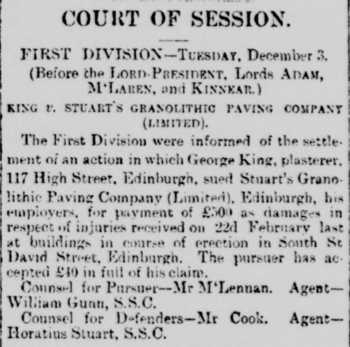
Further research by Mike yielded the information that one of the King family of plasterers, likely George Greaves King, Snr., was a plasterer employed on the completion of the prestigious Jenners  department store in the centre of Edinburgh, Scotland’s oldest independent department store opened 11 years prior to the King’s Theatre in 1895.
department store in the centre of Edinburgh, Scotland’s oldest independent department store opened 11 years prior to the King’s Theatre in 1895.
While working at Jenners in the spring of 1895, King tripped and fell down an exposed lift [elevator] shaft, was comatose for multiple months, and ultimately sued his then employer, Stuart’s Granolithic Company of Edinburgh. King’s initial claim was for £500 (equivalent to £84,000 in 2025) however he ended-up settling for £40 (£6,700 in 2025 money) in late 1895.
This is the sort of discovery everyone hopes for on a project of this scale. When the builders of the King’s Theatre placed this special trinket at the absolute apex of the auditorium, they intended to honour the local people who built the theatre, and for the long term.
It’s astonishing to think that this small time capsule of history has been hidden in plain sight for nearly 120 years, silently bearing witness to the countless famous faces – and Edinburgh community performers – that have graced the stage of the King’s.
I think that rediscovering this amazing time capsule would be all that the builders hoped for when they put it up there, as here we are nearly 120 years later researching their histories and honouring their legacy in redeveloping their King’s Theatre – the People’s theatre of Edinburgh – for the next 100 years.
I am both honoured and humbled to have found and highlighted the legacy of the builders of the King’s Theatre. Discussions are underway with Capital Theatres on how we will honour and document what we have found.
The King’s Theatre in Edinburgh and the New Victory Theater in New York have another link in common: artist John Byrne, who painted the auditorium ceiling dome of the King’s Theatre in 2013, also painted at the New Victory Theater in 2009 as part of a promenade production of “Hansel and Gretel” which transferred internationally as part of the New Victory Scottish Festival in 2009, the production being presented by Catherine Wheels Theatre Company in association with the Brunton Theatre. Byrne’s painting is still in situ at the New Victory Theater and can be seen on the Broadway Up Close tour of the theatre  .
.
William Stuart Cruikshank, the builder of the King’s Theatre, clearly intended that someone would find this message some day. The King’s Theatre and my experiences there as a young child, from seeing my Dad working on glorious Gilbert & Sullivan sets, to the sumptuous pantomimes of my youth starring Stanley Baxter, Rikki Fulton, Una McLean and the rest, to sitting-in on LX plotting sessions with renowned UK theatre lighting designer Francis Reid who had written books I’d studied for years, instilled an insatiable interest in theatre in me – and so I’m beyond delighted – but also humbled – that it was me who found this secret message hidden in plain sight for nearly 120 years, at the theatre’s very heart.
Long may that heart continue to beat.

Mike Hume, 23rd February 2025
The story leads on the front page of the 25th March 2025 edition of the Edinburgh Evening News:
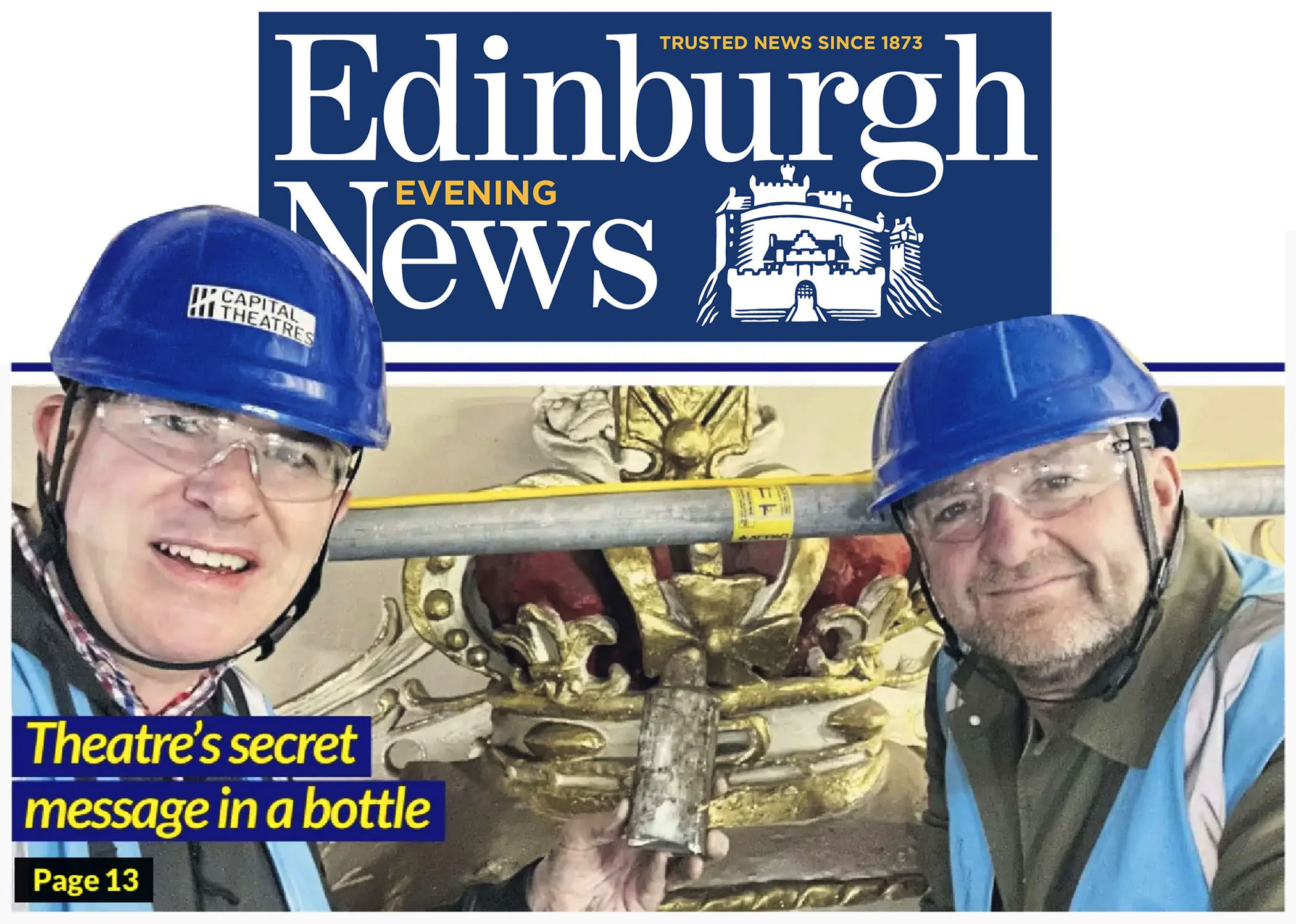
National newspaper Metro runs the story, in late March 2025, on page three:

The story was featured in the 16th April 2025 edition of The People’s Friend:

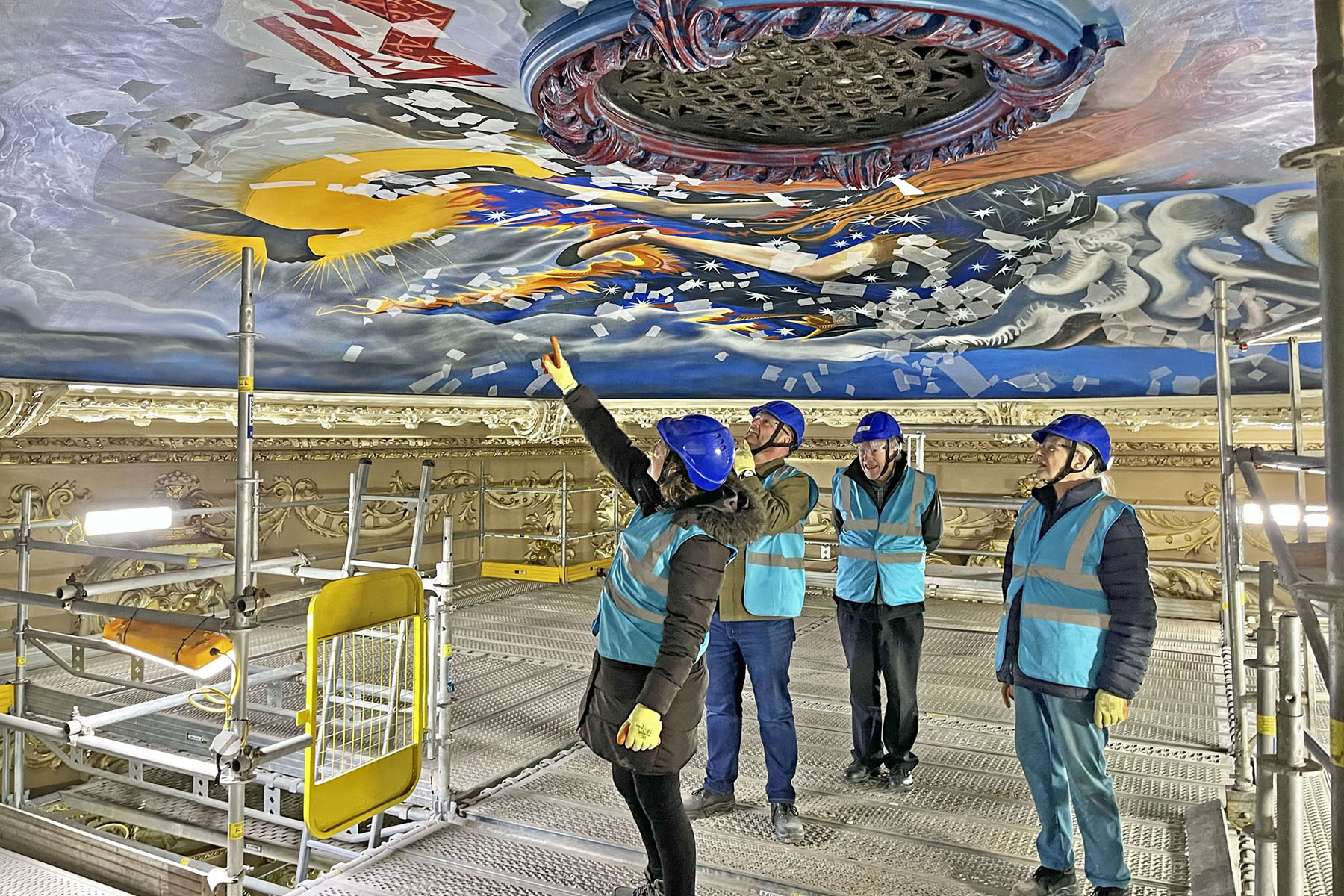
Capital Theatres staff Lucille Bluefield and John Robb tour Mike’s parents around the ’dancefloor’ just underneath the ceiling of the theatre’s auditorium.
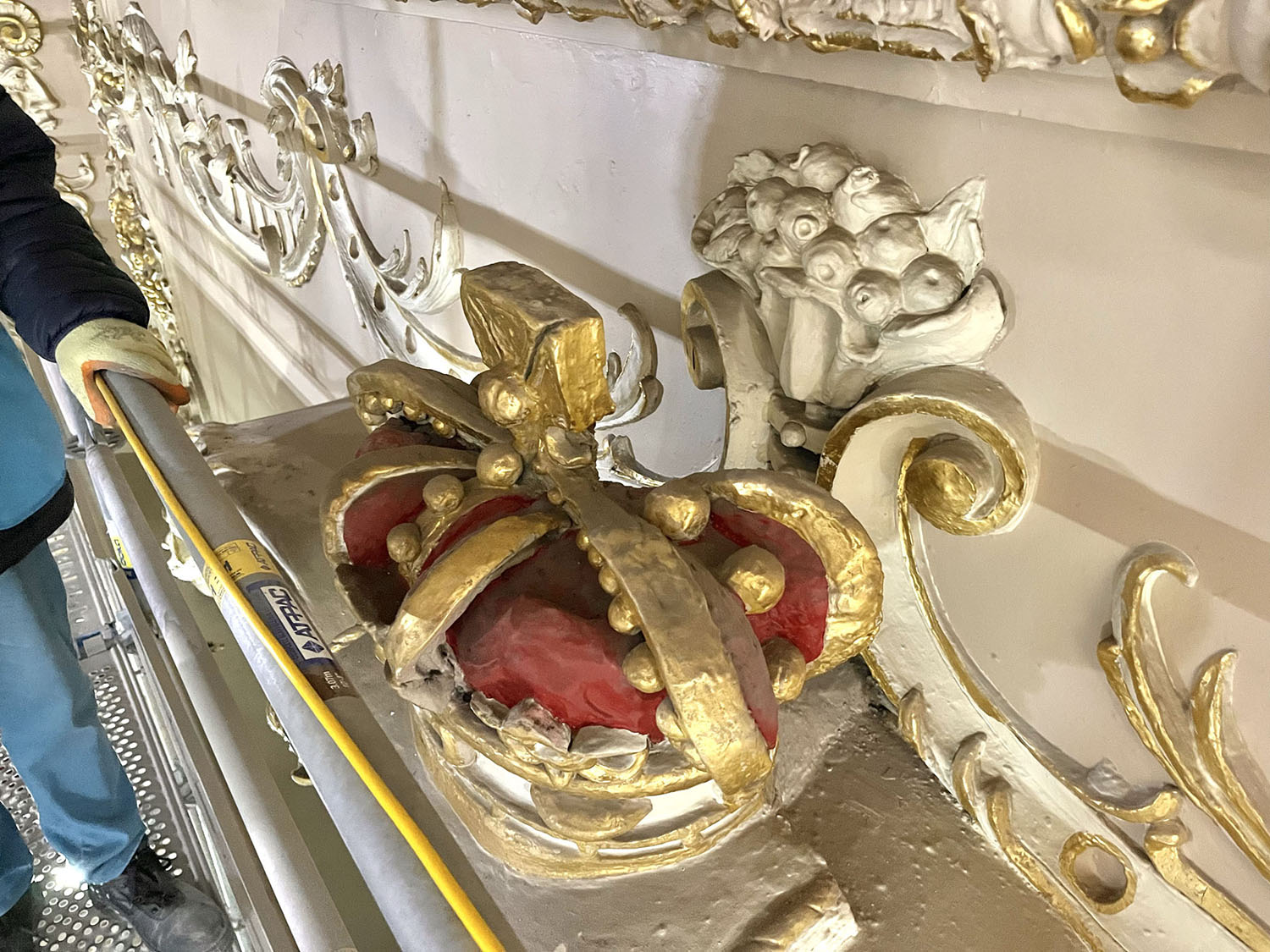
The central plaster crown as seen from the temporary dancefloor. The crown holds the central position within the auditorium, being mounted above the centre of the proscenium arch.
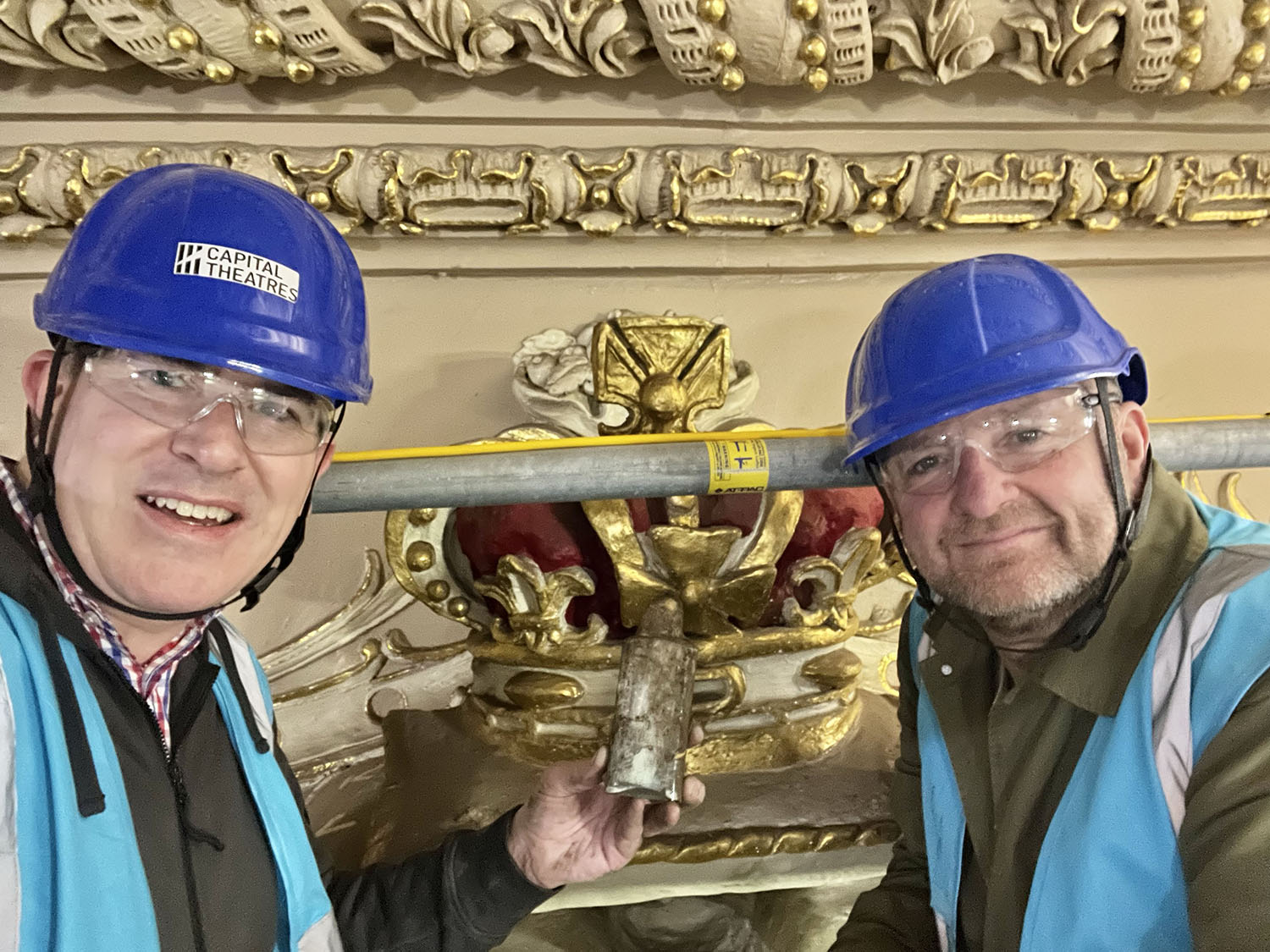
Mike discovers the hidden bottle and poses with John Robb of Capital Theatres to celebrate the find from inside the plaster crown directly behind.
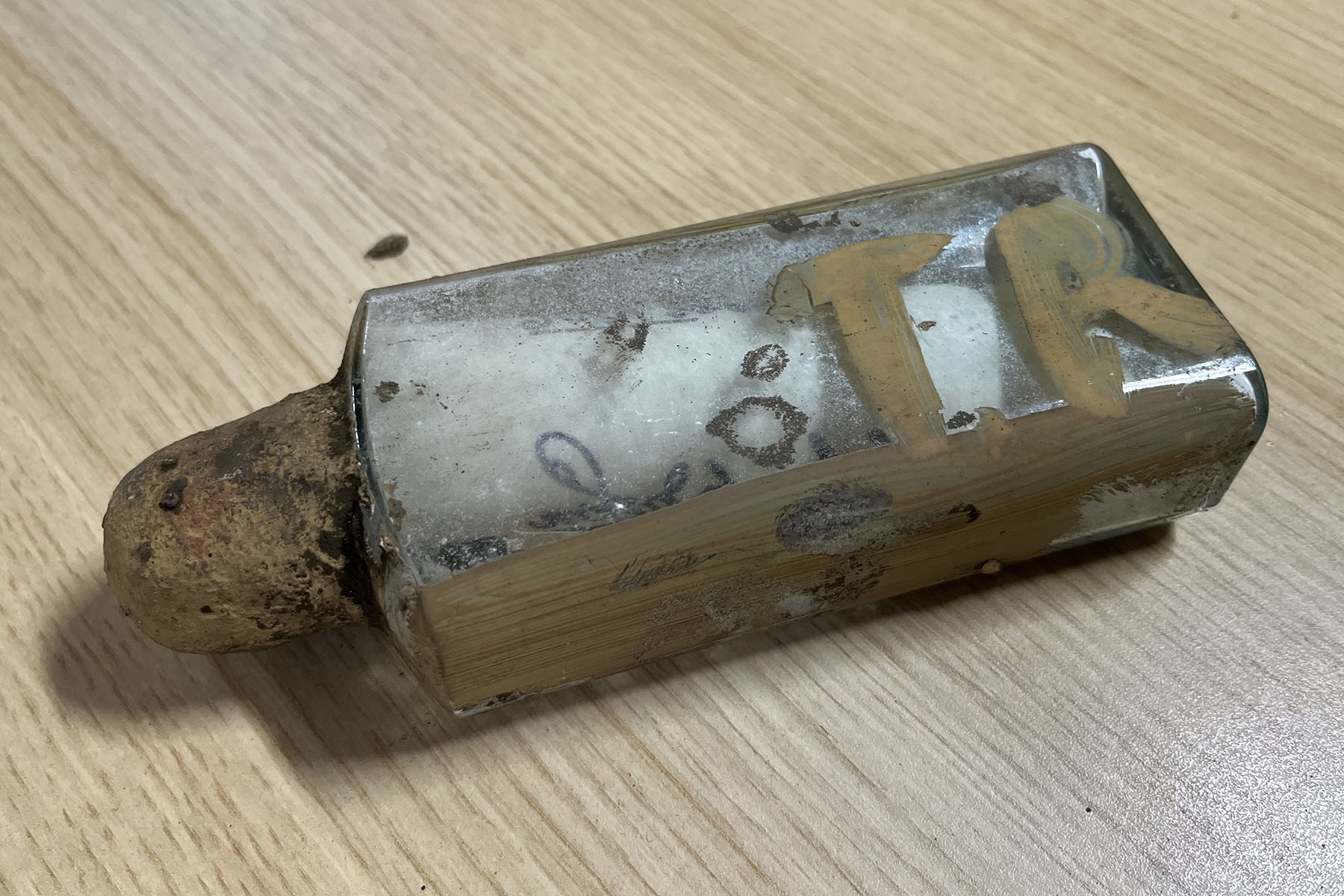
The paint on the bottle’s exterior matches the shadow colour used in the auditorium. There are not many instances of it as most paint is cream or gold, however the darker tan colour can been seen on the underneath of lintel lines as a shadow colour suggesting the cream paint in hidden in shadow.
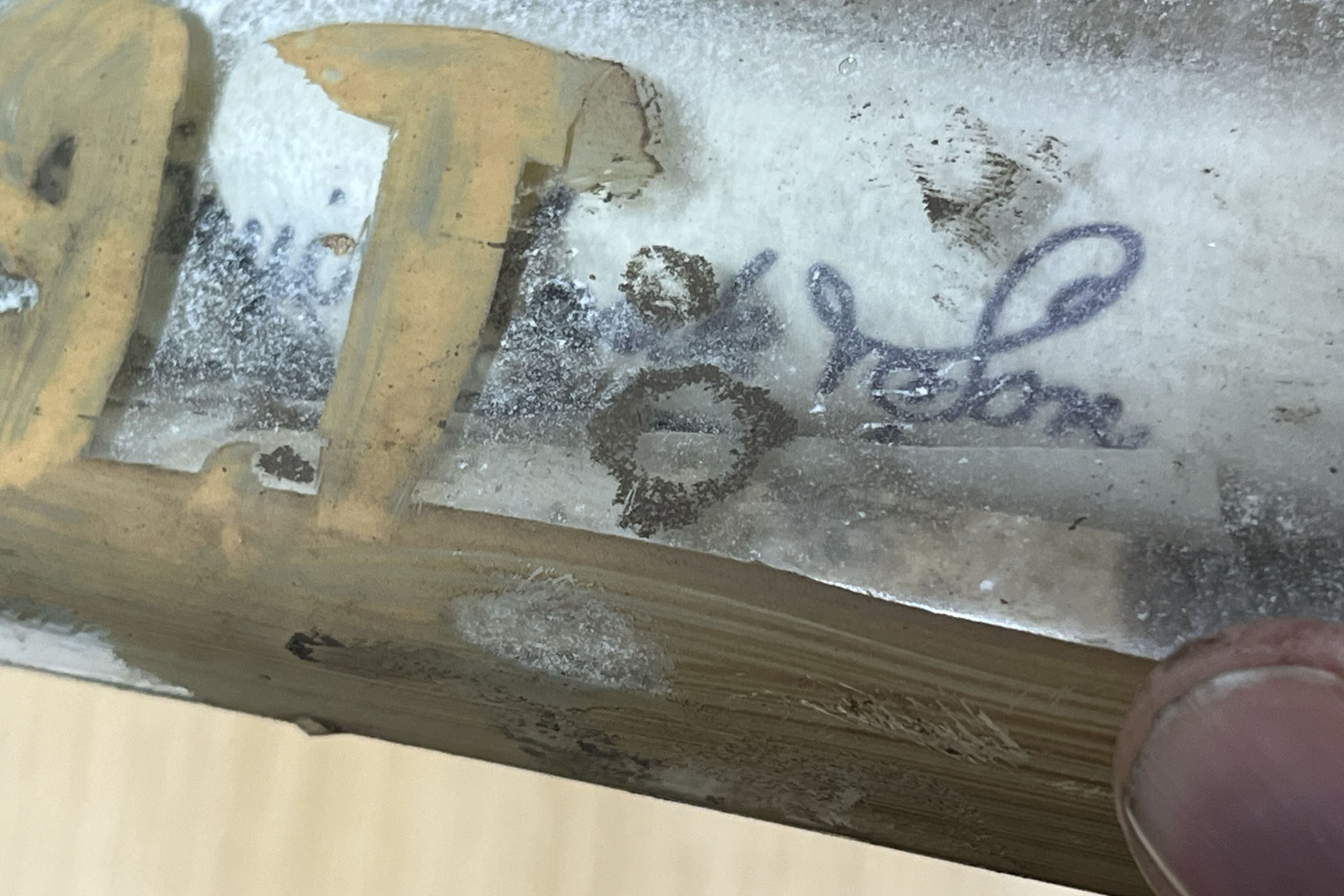
The writing inside the bottle appears to say “Cruikshank & Son” – the name of the builders of the theatre.
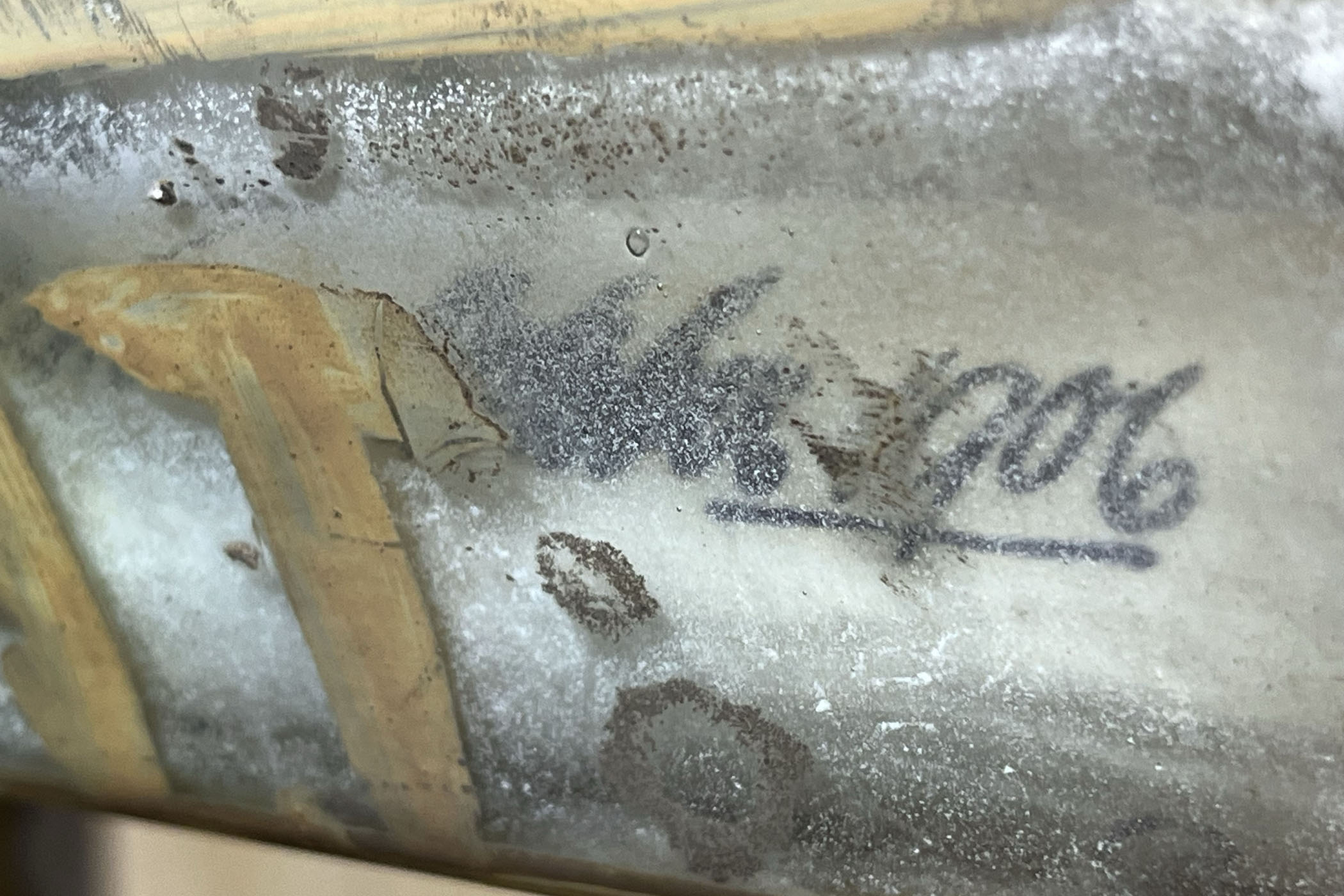
Another section of writing inside the bottle has the digits 1906, and perhaps the word October before it.

A photo of the rear of the plaster crown. The bottle was found in the lower hole in the base of the crown.
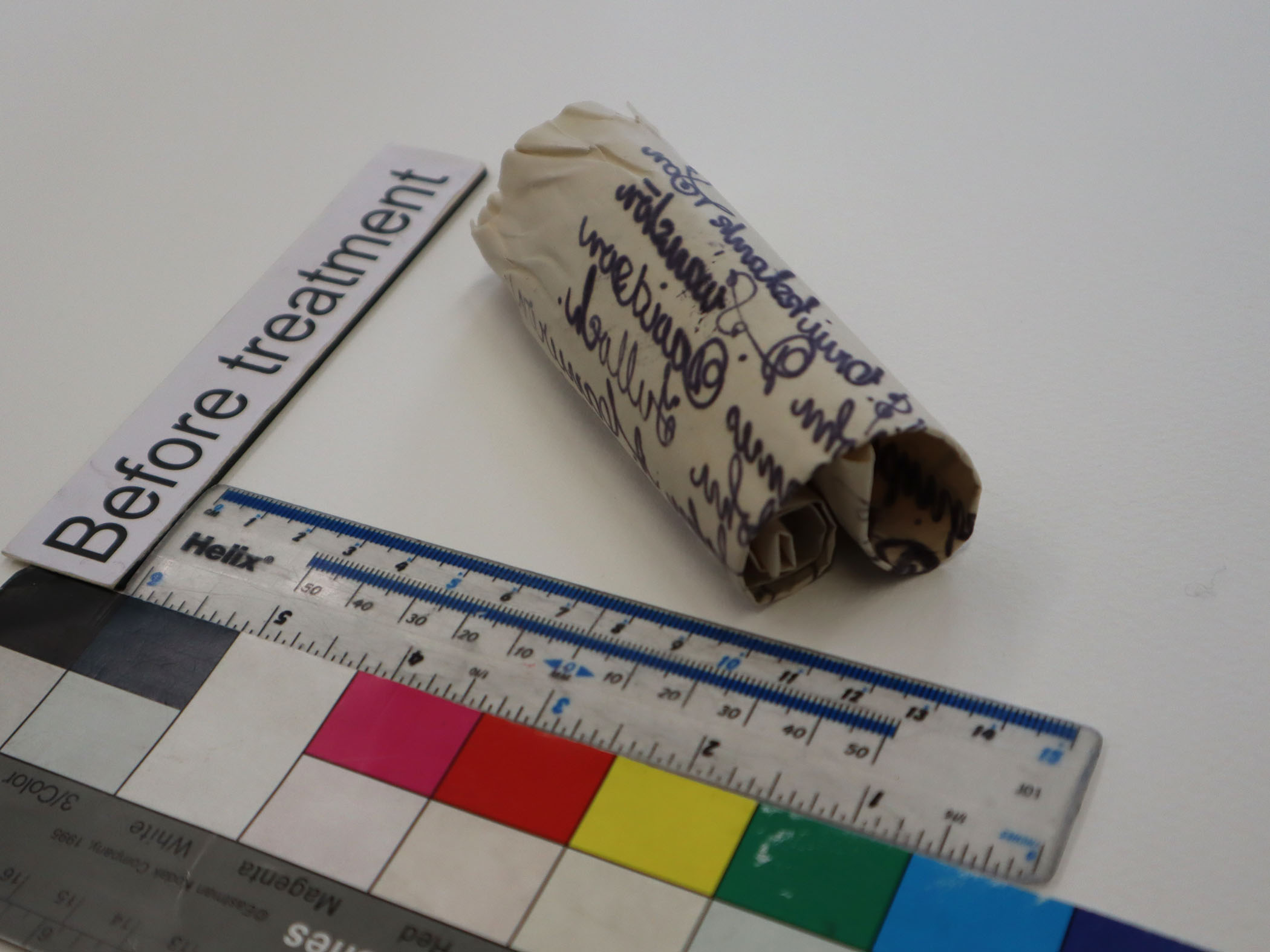
The rolled-up scroll of paper after it was extracted from inside the bottle; photo courtesy Capital Theatres.
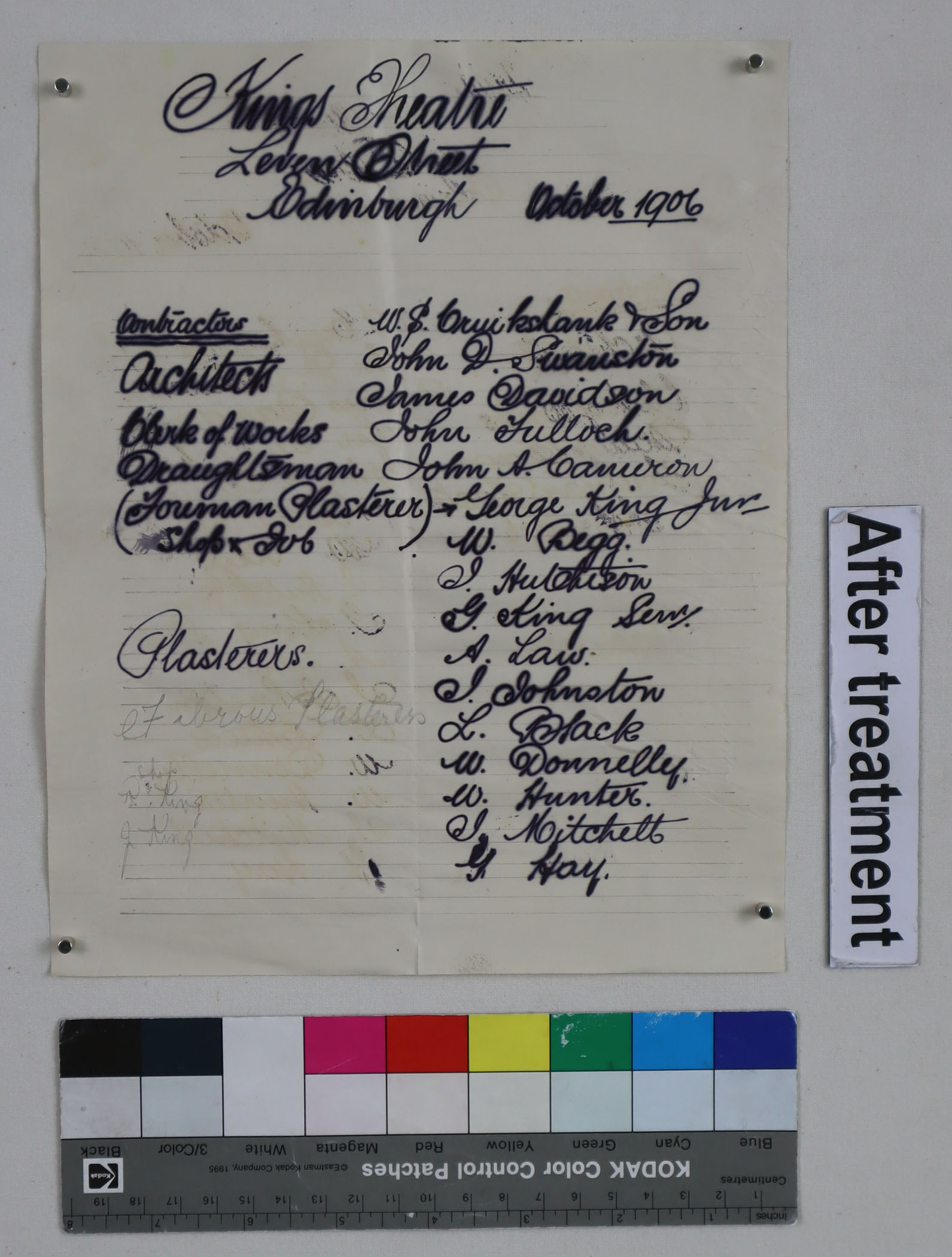
The paper unfolded and fully exposed, showing the names of the people who built the theatre; photo courtesy Capital Theatres.
Photographs copyright © 2002-2025 Mike Hume / Historic Theatre Photos unless otherwise noted.
Text copyright © 2017-2025 Mike Hume / Historic Theatre Photos.
For photograph licensing and/or re-use contact us here  . See our Sharing Guidelines here
. See our Sharing Guidelines here  .
.
| Follow Mike Hume’s Historic Theatre Photography: |  |
 |